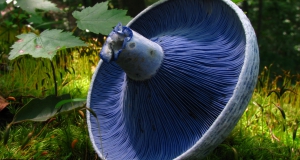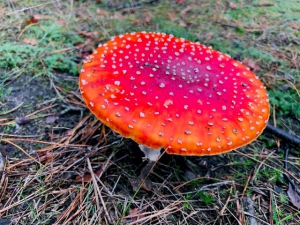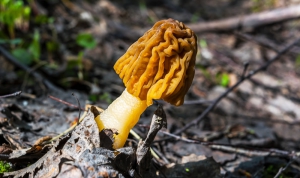A mushroom with a special appearance
When you think of mushrooms, you often think of spring. But do you also know why so many mushrooms can be found in the autumn? This is because it generally rains a lot in the autumn while the temperature is still fairly high. Then it is moist and warm and mushrooms love that. Of course they stand out because of their beautiful colors and the most famous and one of the most colorful is of course the Amanita Muscaria, but which is not edible!
They can be found in all colors but the Lactarius Indigo with its appearance, is a very special one. Commonly known as the Indigo Milk Cap, this blue mushroom grows most in North Africa, Central America and East Asia. The Lactarius Indigo grows on the ground in both deciduous and coniferous forests. The color of the fruiting body and also the milk that oozes when the mushroom tissue is cut, is indigo blue.
If you have read the foregoing you would think that this must be a very poisonous mushroom. But despite its color, this mushroom is not poisonous and completely edible. They have a bitter, peppery taste. When you cook them, the taste is similar to a portobello. Lactarius indigos lose some of their blue color during cooking and turn greyish-blue. You can use them for example, in a grilled dish or in a soup. But in whatever dish you use this beautiful mushroom, the dish looks heavenly.
Credits for photo: Dan Molter/Wikimedia Commons
Mushroom picking not always without danger!
Mushrooming may seem like a fun activity, but it can also be quite dangerous. There are many types of mushrooms and many are edible and very delicious. Unfortunately, this does not apply to all species. Eating non-edible mushrooms that contain chemicals can make you seriously ill and even be fatal.
But how do you tell the difference between an edible and a poisonous mushroom?
Recognizing poisonous mushrooms can be life-saving, so that is why we like to give some very important tips.
Mushrooms with white gills are often poisonous, the same also applies to mushrooms with a ring around the stem and those with a volva. So it's important to dig around the base of a mushroom to look for it.
Mushrooms with a red color on the cap or stem, are also poisonous.
Symptoms of mushroom poisoning can range from stomach upset to organ failure, which can result in death. Severe symptoms do not always appear immediately after eating, often only when the toxin attacks the kidney or liver. This can be days or weeks later. Anyone who becomes ill after eating a poisonous mushroom should seek urgently medical attention.
These are the 7 most poisonous species growing around the world:
- Death Cap Mushroom (Amanita phalloides)
- as the name implies, the deadliest of all mushrooms
- and also be aware that they closely resemble Poland's popular, edible parasol mushroom - Conocybe Filaris
- Web Caps (Cortinarius rubellus)
- Autumn Skullcap (Galerina marginata)
- Destroying Angel (Amanita verna)
- Podostroma Cornu-Damae
- Deadly Dapperling (Lepiota brunneoincarnata)
So are you going out to pick mushrooms? Then make sure you pick an edible one to use in your risotto!
Go on a Morel hunt!
Spring is back in the country and that is the start of the morel season. A good knife and a sharp eye are all it takes to harvest delicious morels.
The morels are mushrooms that grow in the spring. Morels have a spongy, pointed hat that is reminiscent of a honeycomb. Raw morels are poisonous and only edible after heating. The taste of the morels is spicy. Morels are full of fiber and minerals and are therefore also good for your health.
If you plan to do your own research, read carefully so that you don't pick a poisonous species. When collecting morels use a flat box, basket or net bag. Don't use plastic bags as the morels will start to spoil before you bring them home. Another reason is that the spores must be able to fall back to the ground so that new morels will grow again next year. Morels are often found around dead and dying trees. Think of oak, ash and elm. But an old apple orchard is also a good hunting ground.
There are many ways to cook morels, but baking them in butter brings out their rich, almost meaty flavor. You can make it a real springtime celebration by serving them with asparagus during this time of year.
























